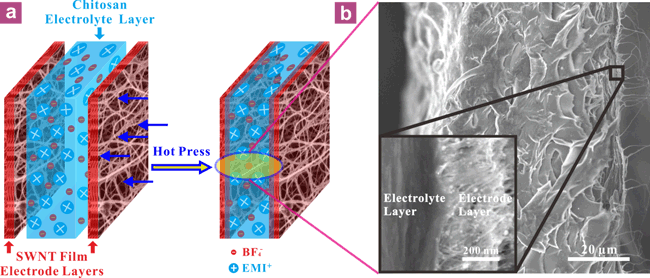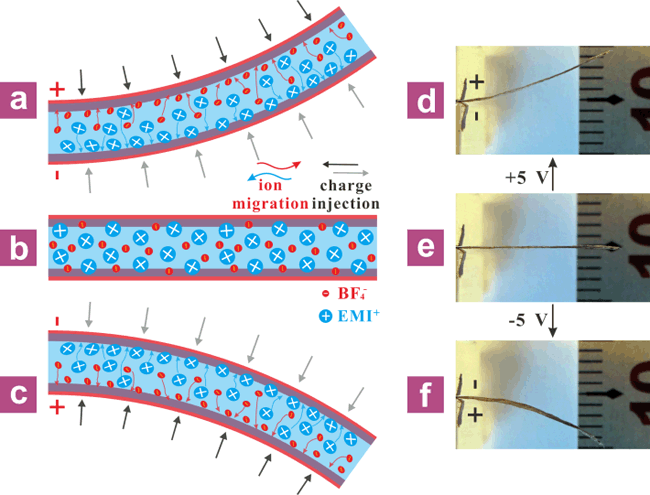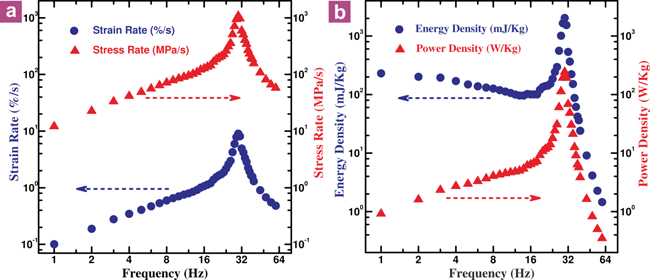Superfast-Response and Ultrahigh-Power-Density Artificial Muscle Actuators Based on Hierarchical SWNT Films
Date:10-01-2012 Print
Carbon nanotubes (CNTs) have shown high specific surface area, exceptional mechanical and electrical properties, making them prime candidates for high strength composites, energy storage and conversion devices such as supercapacitors and actuators. Electromechanical actuator materials that directly convert electrical energy to mechanical energy have great potential for many applications including artificial muscles for robots, biomimetic flyings, optical switches and microsensors and so on. In particular, ionic electroactive polymer (i-EAP) actuators attract increasing attentions due to their lightweight, low driving voltage and operability without aqueous solution. However, the slow response (timescale of seconds to minutes), very low and narrow working frequency range (usually <1 Hz), and low mechanical output abilities severely hamper their developments and potential applications.
Prof. Sishen Xie and his research team (group A05) at Institute of Physics, Chinese Academy of Sciences, have reported a series of original research work aiming at the fabrication, fundamental properties and applications of CNTs. Representative research achievements in the past few years include fabrication of strong, highly conducting and transparent large-area freestanding SWNTs films (Nano. Lett. 2007, 7, 2307), high strength macro SWNTs fibers (Adv. Mater. 2009, 21, 603), high performance and functional SWNTs composite fibers (Nano. Lett. 2009, 9, 2855) and films(Nanoscale 2011, 3, 3731) as well as compact-desined supercapacators using free-standing flexible SWCNT films (Energy Environ. Sci. 2011, 4, 1440).
Recently, PhD student Jinzhu Li et al. in group A05 made a progress on fabrication of artificial muscle actuators based on hierarchical SWNTs. They reported a novel SWNTs-based bimorph electromechanical actuator, which consists of unique as-grown SWNT films as double electrode layers separated by chitosan electrolyte layer of an ionic liquid. By taking advantages of the special hierarchical structure and the outstanding electrical and mechanical properties of the SWNTs film electrodes, this actuator shows orders-of-magnitude improvement in many aspects compared to previous ionic electroactive polymer (i-EAP) actuators, including superfast response (19 ms), quite wide working frequency range (dozens to hundreds of Hz), extremely large stress generating rate (1080MPa/s) and ultrahigh mechanical output power density (244 W/Kg). These remarkable achievements together with their facile fabrication, lightweight, flexibility, low driving voltage, controllability in air (without aqueous solution), and long durability enable the SWNTs-based actuators many applications such as artificial muscles for biomimetic flying insects or robots and flexible deployable reflectors. The details of the work have been published recently in Nano Lett. 2011, 11, 4636-4641.
This work was supported by Chinese Academy of Sciences, the National Natural Science Foundation of China, the Ministry of Science and Technology of China, and Beijing Municipal Education Commission.
Article Linkage:
1.Superfast-Response and Ultrahigh-Power-Density Electromechanical Actuators Based on Hierarchical Carbon Nanotube Electrodes and Chitosan.pdf
2.High performance, freestanding and superthin carbon nanotube/epoxy nanocomposite films.pdf
 |
| Figure 1. Assembly and structural characterization of the SWNTs-based actuators. Schematic diagram of the assembly (a) and typical SEM cross sectional image (b) of the bimorph configuration actuator. |
 |
| Figure 2. Electromechanical actuation mechanism of the SWNTs-based actuator. Actuation illustration (a-c) and corresponding experimental photographs (d-f) of the bimorph configured actuator under a positive (a, d), negative (c, f) and without (b, e) an applied electrical field. |
 |
| Figure 3. Superfast electromechanical actuationresponse of the SWNTs-based actuator.(a) Normalized displacement versus time under 4 V square wave voltage of 1 Hz. (b) One period extracted from (a) for EMD model analysis. |
 |
| Figure 4. High mechanical output abilities of the SWNTs-based actuator. Strain and stress generating rates in the electrode layers (a) as well as the corresponding mechanical output work and power densities (b) as a function of the driving frequency. |

